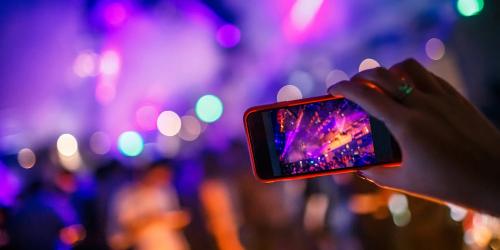Today more than ever, we live disconnected from the variations of daylight. But being deficient in natural light can prove ultimately as harmful as being deficient in certain nutrients.
Virtually all the lighting fixtures in offices, shops, schools, hospitals and apartments distill only a truncated part of the light spectrum. Certain wavelengths essential to our psychic and physical equilibrium, especially in blue hues, are not represented. Not to mention their constant light intensity, identical to any time of the day or night, which shields us from the beneficial fluctuations of the sun's cycle.
The biological clock as a conductor
Our eyes, the only organs in our bodies that perceive light waves, are not just for vision. Some photoreceptors they carry do not generate any image on the retina but are connected to deep areas of the brain that coordinate innumerable vital functions.
"They carry electrical impulses to the hypothalamus that controls the autonomic nervous system, thermal regulation, energy balance, activity and sleep, circulation and respiration, growth and maturation, reproduction and reproduction. emotional balance, "says Dr. Jacob Liberman *.
The hypothalamus also governs, through the pituitary gland, the endocrine system, that is to say the hormonal secretions of the thyroid gland, ovaries, breasts, kidneys ...
Certain light waves that penetrate through our eyes (especially those corresponding to the famous blue) will stimulate a small structure no bigger than a pinhead, nestled within the hypothalamus, and which orchestrates the daily rhythm of the body. : our circadian biological clock.
It "synchronizes all the body's functions with its external environment," says Dr. Liberman. And it is also that regulates the synthesis of melatonin, hormone whose rate fluctuates enormously in twenty-four hours: its production, low during the day, becomes strong during the night in response to darkness. It starts around 8 pm to prepare, among other things, for falling asleep, peaks between 2 and 3 am when our eyelids are theoretically closed, and reflux around 7 am to start our awakening. As it is released into the blood, it is found everywhere in the body, so "" none of our cells can escape the influence of light, "says Dr. Liberman.
In addition to its well known effect on sleep, it "gives the time" to all our small decentralized clocks located in the heart of each of our cells to synchronize them. Any disturbance of this chemical "pacemaker", such as a brain injury or a light deficit, can therefore have serious consequences.
Immune defenses put to the test
A disruption of the body clock weakens the immune system, which in turn increases our vulnerability to infections. A Yale University study demonstrated that the synthesis of a protein (TLR9) involved in the recognition of bacteria and viruses was modified. As a result, the white blood cells responsible for neutralizing these invaders are less mobilized, and therefore less effective.
According to Dr. Erol Fikrig, coordinator of this study (published on February 16, 2012 in the journal "Immunity"), a "reset to the circadian clock should improve our responsiveness to pathogens". He also suggests that this dimension be taken into account for the administration of vaccines, as the combativeness of our natural defense arsenal fluctuates throughout the day. Getting vaccinated when our TLR9 protein level is highest should generate better protection.
 martin-dm / iStockphoto.com
martin-dm / iStockphoto.com
Artificial light and weight gain
The energetic metabolism is also placed under the influence of our internal pendulum. As insulin release is regulated by melatonin, it is minimal at night and resumes full function in the morning to manage the influx of sugar in the blood associated with the taking of meals.
Overexposure to artificial light until late at night in fact disrupts this process. Israeli researchers at the University of Haifa showed, in December 2010, that the galloping epidemic of overweight and obesity today could partly come from there.
To impose in our eyes a regular stimulation of light (electric bulbs, television ...) while the sun is already lying down would in addition induce insulin resistance, thus the occurrence of a diabetes.
Night work, a risk factor
Night work has long been suspected of increasing the risk of diabetes . And an analysis of the medical record and the pace of professional life of 170,000 American nurses has provided formal proof. Those who provided their service in staggered hours for three to nine years present a risk 20% higher than that of their sisters in day job.
The increase goes up to 40% for women who have worked ten to nineteen years in these conditions and up to 58% beyond twenty years! And to drive the point, a joint publication of British and French researchers, Institut Pasteur Lille, demonstrated in late January 2012 that a break in the link between the biological clock and the pancreas led to diabetes, following a mutation of melatonin receptors for example.
Circadian rhythms and their impact on the cardiovascular system
Contrary to popular belief, our heart does not pulse identically throughout the day. His beats are faster around 17 hours for most of us. In the same way, our blood pressure is lower at night than during the day, with a minimum around 3 am and a maximum around 4 pm.
To do this well, it should be taken into account when practicing a sport. Not only our physical performance is better in the afternoon, but our cardio-protection is lower before noon. Emergency department staff regularly note that there is more myocardial infarction in the morning and, more importantly, the damage they create is more damaging than heart attacks occurring later in the day. According to cardiologists at the San Carlos Hospital in Madrid who have attempted to quantify the damage according to the time of their occurrence, the severity of morning infarction is 20% higher than the others.
Artificial lighting, source of cancer?
More worrying, overexposure to artificial light would be carcinogenic.
Many researchers have subjected laboratory animals to artificial lighting at night. Their conclusion is unanimous: all of them quickly developed tumors, especially mammary tumors. In contrast, cancer animals kept under long periods of nocturnal darkness saw their disease progress very slowly.
The explanation would come once again from melatonin. When daylight cycles are nearly respected, a plethora of melatonin is released into our blood at times when the sun is normally lying down. But "this hormone prevents tumor cells from using linoleic acid as a growth booster," says Dr. David Blask, a neuro-endocrinologist at the University of Philadelphia who has demonstrated this phenomenon in mice.
The cancer progresses so low noise. With this in mind, this researcher advocates the development of lighting whose intensity varies with the hours and whose wavelengths would not hinder the production of melatonin.
 wundervisuals / iStockphoto.com
wundervisuals / iStockphoto.com
The benefits of chronotherapy in chemotherapy
Rather than suffer our biological clock, some oncologists try to make it an asset by using chronotherapy.
It is about distilling the chemotherapy treatment at the precise moment when the body is the most receptive and the least fragile. Inserm's "Cancer Rhythms and Cancers" research unit has proven that the harmfulness and effectiveness of anticancer drugs vary greatly depending on the time of administration.
Fluorouracil, used to heal colorectal cancers, is up to five times less toxic when infused at 4 am instead of 16 hours.
Men and women, at each tempo
According to an American study of May 2011, carried out in collaboration with Claude Gronfier, of the chronobiology department of Inserm, the circadian biological clock of the female population would be faster than that of men: six minutes in advance per day approximately.
Minime, certainly, but the consequence is no less important.
The intrinsic daily cycle of the majority of women turns out to be less than twenty-four hours. Hence their need even stronger to put their "clock on time" by the light. But many of them do not do it, or not enough, and in fact are even more out of sync.
Going to sleep later than their internal clock would, they wake up spontaneously sooner than men. Hence "insufficient sleep and often difficulty falling asleep," notes Claude Gronfier.
This is probably why women are more prone to insomnia.
Daylight and medicines: the ideal time?
A study published in the Journal of the American College of Cardiology suggests that the effect of angiotensin-converting enzyme inhibitors (molecules prescribed for high blood pressure and heart failure) is optimal at bedtime . When they wake up, they are hardly more effective than a placebo.
It is the same for many common drugs. According to Dr. Marc Schwob, ** aspirin tablets and antiallergics should be swallowed rather in the evening. And nonsteroidal anti-inflammatory drugs as well as tranquilizers preferably in the morning.
The rhythm in the skin
The metabolism of our skin cells is influenced by the ticking of our internal clock. The activity of their genes fluctuates throughout our wake-sleep cycle.
According to a study from the University of North Carolina (published in September 2011 in the journal of the American Academy of Sciences), these variations have an impact on their ability to repair DNA, that is, to say their susceptibility to becoming cancerous after exposure to the sun.
UV mice in the morning (when they usually sleep) were five times less protected from carcinoma than those exposed twelve hours later at their usual discharge schedule. If the same mechanism exists at home, it means that we should not expose ourselves to the hours when we usually sleep. Early risers will need to fine-tune their tans early in the morning, and late risers not until early afternoon. Not to mention their sun protection.
In conclusion, we take advantage of the beautiful days to put our clocks back on time to maintain optimal health. We fill up the natural light by going out to the maximum, ideally in the morning, even to stay in the shade. Anything that can be done outdoors should not be done indoors. And if one must remain confined, one sits if possible near an open window letting in some light rays. Let the sun shine in ...
* Author of "Light - Medicine of the future" (The Courier of the Book).
** Author of the book "Les Rythmes du corps" (Odile Jacob).




